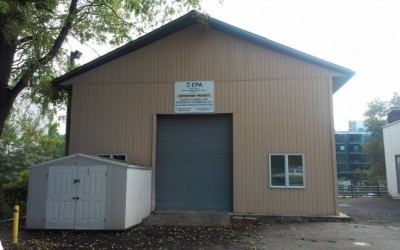The owners of a decades-old toxic waste site in Great Neck must pay a six-figure settlement and sell the property where the contamination occured, according to a lawsuit settlement announced Saturday by federal authorities.
The Environmental Protection Agency and the Department of Justice sued John P. Maffei and the estate of Lillian Wiesner in 2005 for costs incurred to clean up Stanton Cleaners’ dumping of toxic drycleaning byproducts at 110 Cuttermill Road in the Village of Great Neck Plaza.
The settlement requires that Maffei and Wiesner’s estate pay the federal government $756,000 and an estimate $2 million from the mandated sale of the property.
“This settlement reflects the ongoing commitment of this Office to the elimination of toxic waste sites that can threaten human health and safety,” said United States Attorney Loretta Lynch in a press release. “This Office will continue to hold those responsible for causing or contributing to hazardous waste sites accountable under the law.”
Stanton Cleaners contaminated public wells and the air in nearby buildings with perchloroethylene (PCE), a dry-cleaning chemical linked to increased risk of cancer, according to a 2005 public health assessment. The site was added to the federal Superfund list of hazardous waste sites in 1999, and the lawsuit was filed in 2005.
Wiesner, the owner of the building during the time the property was polluted, died prior to the lawsuit’s filing.
Maffei, who according to the complaint was the long-time leaseholder and de-facto owner of the site, subleased the property to Stanton Cleaners.
“Chemicals like PCE can cause serious health effects and EPA took action to reduce the risks posed by chemicals at this site, including treating of over 270 million gallons of contaminated ground water, installing systems to take vapors out of the soil that can get into buildings and installing a system in a building where vapors were getting in,” said EPA Regional Administrator Judith Enck in a press release. “With this settlement, the parties responsible for the pollution are being held accountable for their part in the contamination.”
The presence of PCE in public buildings drew concern from residents and regulators. Levels up to 28 times state Department of Health guidance values were found on tennis courts at the now-demolished Plaza Tennis building, before decontamination efforts in 1998 lowered chemical concentrations.
The site has a long history of pollution, according to the public health assessment.
Dry cleaning operations contaminated the ground behind the property with PCE from about 1958 to 1983, prompting a series of investigations and response measures.
State regulators oversaw cleanup efforts from 1984 to 1998, when the EPA investigated the site and, in 1999, added it to the Superfund list.
Among the measures taken by the EPA was the installation of a soil vapor extraction system, which reduced indoor air exposure to PCE, according to the public health assessment.
In addition to increased cancer risk, long-term inhalation of PCE is linked to fertility problems and adverse effects to the central nervous system, kidneys and liver.
The property is currently occupied by New Stanton Cleaners, a dry cleaning service that is not linked to the lawsuit or PCE contamination.
Reach reporter Dan Glaun by e-mail at dglaun@theislandnow.com or by phone at 516.307.1045 x203. Also follow us on Twitter @theislandnow1 and Facebook at facebook.com/theislandnow.



